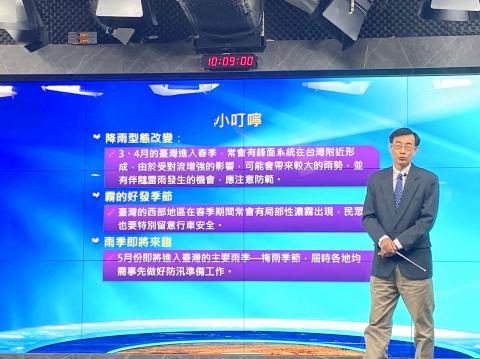People can expect a drier and warmer spring this year, the Central Weather Bureau (CWB) said yesterday, ahead of the start of the spring season this weekend.
The equatorial Pacific sea temperature is relatively warmer at the moment, which is likely to reduce humidity across the nation and cause temperatures to rise further, Weather Forecast Center Deputy Director Fong Chin-tzu (馮欽賜) said, adding that the phenomenon would be particularly apparent next month and in April.
The spring weather forecast for this year generally corresponds to the trend that has emerged since the 1990s, with rain in the west coast decreasing over the years, Fong said.

Photo: Hsiao Yu-hsin, Taipei Times
The nation would see normal to lower than normal rainfall from next month to April, the bureau forecast.
The average temperature between next month and May has a greater chance of being warmer than normal, it said.
Despite forecasts of a warmer spring, the bureau said there could still be cold spells coming from the north.
Between next month and April, thick fog would frequently occur on the west coast, as well as in Kinmen and Lienchiang counties, it added.
Before the start of the “plum rains” in May and June, central and southern Taiwan would continue to experience a dry spell, the bureau said, urging residents in these areas to conserve water during this period.
As the weather tends to change faster in springtime, which in turn raises the level of uncertainty in weather forecasts, the public is advised to regularly check weather updates from the bureau, it said.
The nation experienced a warmer-than-normal winter, despite the arrival of two cold spells — one strong cold air mass and four weaker cold air masses between December last year and February, it said.
The phenomenon was caused by a weaker high-pressure system, it said.
The central, southern and southeastern regions saw normal to slightly higher than normal rainfall this winter due to the humidity brought by weather fronts and cloud systems in southern China, bureau statistics showed.
Although rainfall in the north and northeast was greater than that in the central and southern regions, it was still slightly less than normal, the bureau said.

US climber Alex Honnold is to attempt to scale Taipei 101 without a rope and harness in a live Netflix special on Jan. 24, the streaming platform announced on Wednesday. Accounting for the time difference, the two-hour broadcast of Honnold’s climb, called Skyscraper Live, is to air on Jan. 23 in the US, Netflix said in a statement. Honnold, 40, was the first person ever to free solo climb the 900m El Capitan rock formation in Yosemite National Park — a feat that was recorded and later made into the 2018 documentary film Free Solo. Netflix previewed Skyscraper Live in October, after videos

Starting on Jan. 1, YouBike riders must have insurance to use the service, and a six-month trial of NT$5 coupons under certain conditions would be implemented to balance bike shortages, a joint statement from transportation departments across Taipei, New Taipei City and Taoyuan announced yesterday. The rental bike system operator said that coupons would be offered to riders to rent bikes from full stations, for riders who take out an electric-assisted bike from a full station, and for riders who return a bike to an empty station. All riders with YouBike accounts are automatically eligible for the program, and each membership account

NUMBERS IMBALANCE: More than 4 million Taiwanese have visited China this year, while only about half a million Chinese have visited here Beijing has yet to respond to Taiwan’s requests for negotiation over matters related to the recovery of cross-strait tourism, the Tourism Administration said yesterday. Taiwan’s tourism authority issued the statement after Chinese-language daily the China Times reported yesterday that the government’s policy of banning group tours to China does not stop Taiwanese from visiting the country. As of October, more than 4.2 million had traveled to China this year, exceeding last year. Beijing estimated the number of Taiwanese tourists in China could reach 4.5 million this year. By contrast, only 500,000 Chinese tourists are expected in Taiwan, the report said. The report

Temperatures are forecast to drop steadily as a continental cold air mass moves across Taiwan, with some areas also likely to see heavy rainfall, the Central Weather Administration (CWA) said. From today through early tomorrow, a cold air mass would keep temperatures low across central and northern Taiwan, and the eastern half of Taiwan proper, with isolated brief showers forecast along Keelung’s north coast, Taipei and New Taipei City’s mountainous areas and eastern Taiwan, it said. Lows of 11°C to 15°C are forecast in central and northern Taiwan, Yilan County, and the outlying Kinmen and Lienchiang (Matsu) counties, and 14°C to 17°C